Lead Learning Strategy and Implementation: Comprehensive Report
VerifiedAdded on 2023/04/24
|24
|6372
|233
Report
AI Summary
This report delves into the intricacies of lead learning strategy and its practical implementation within an organizational context. It begins by exploring international e-compliance systems and learning approaches, followed by a detailed examination of TESQA's risk assessment approach. The report then addresses relevant authority compliance requirements for Registered Training Organizations (RTOs), including legislative and standard compliance obligations. It identifies pertinent legislation, codes of practice, and national standards for individual leading strategy management. Furthermore, it outlines technology and systems requirements essential for supporting an organizational learning strategy, along with an analysis of organizational theories such as classical and scientific management. The report also investigates organizational evaluation strategies, the functionality of contemporary organizational learning strategy design and development, and continuous improvement processes. It examines the implementation process of an organization's learning strategy, consultation and communication processes, and the roles of various stakeholders. The report also explores authoritative responsibilities and parameters, contemporary approaches to assessment instrument and strategy design, and quality management compliance requirements in organizational learning.
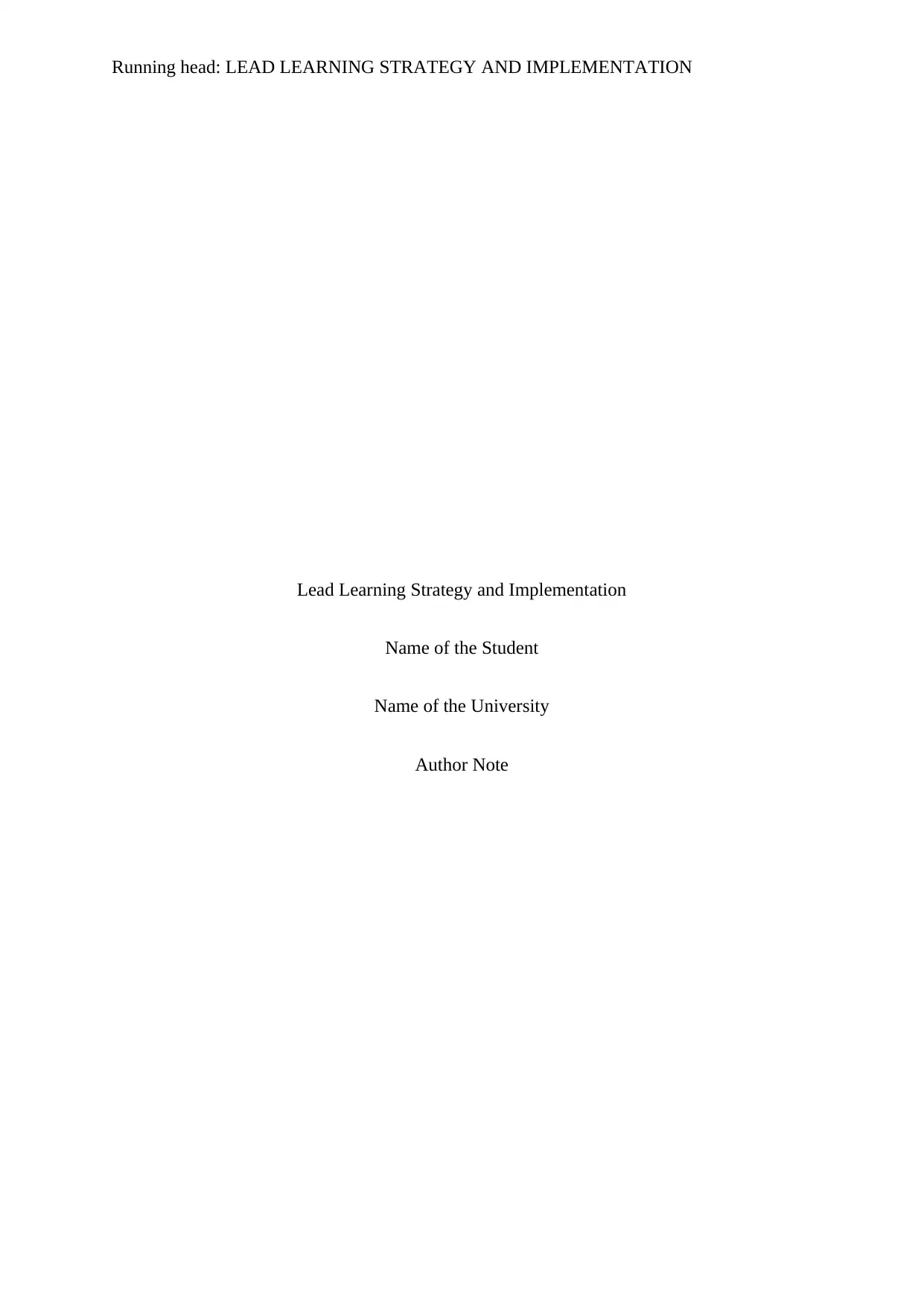
Running head: LEAD LEARNING STRATEGY AND IMPLEMENTATION
Lead Learning Strategy and Implementation
Name of the Student
Name of the University
Author Note
Lead Learning Strategy and Implementation
Name of the Student
Name of the University
Author Note
Paraphrase This Document
Need a fresh take? Get an instant paraphrase of this document with our AI Paraphraser
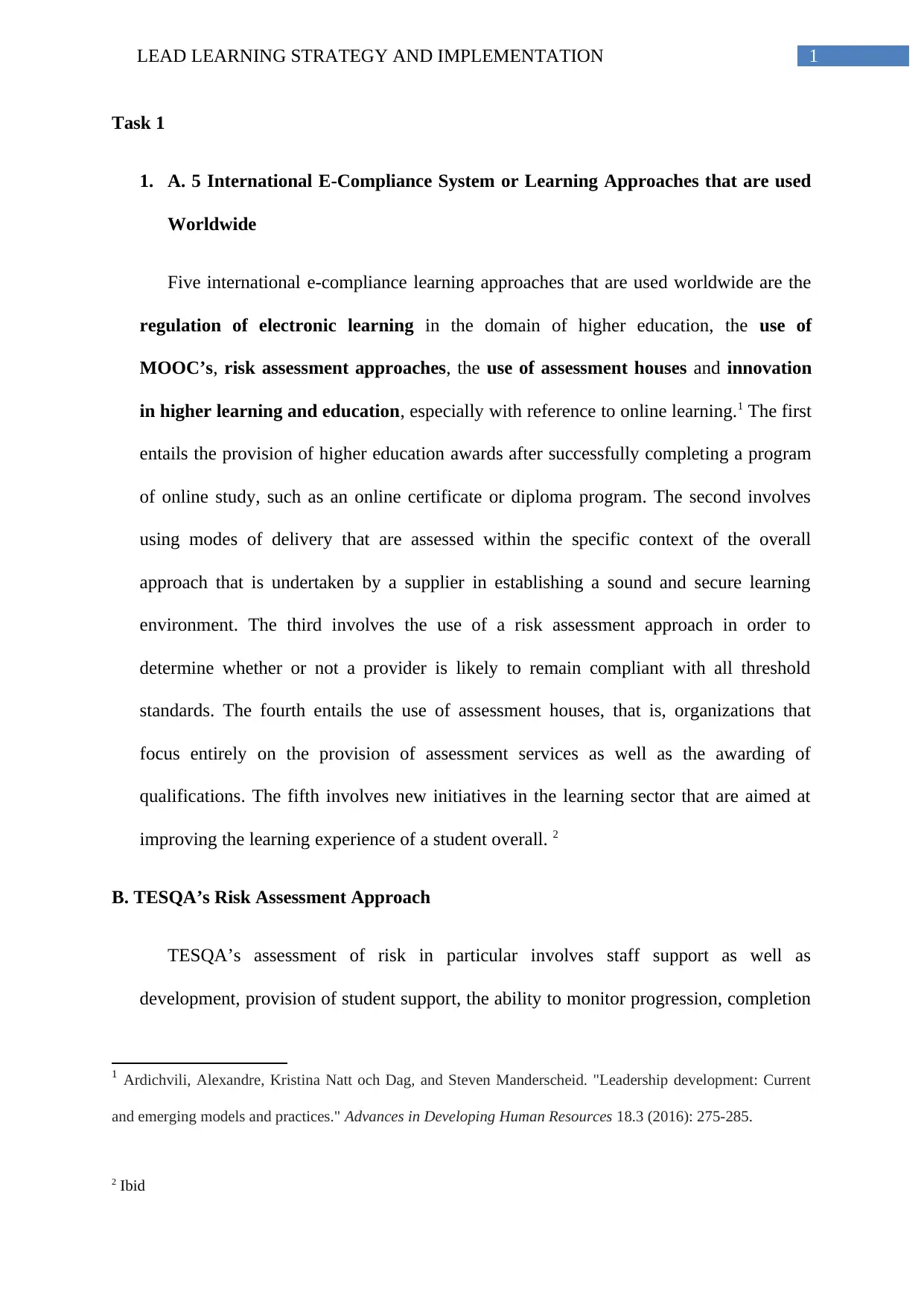
1LEAD LEARNING STRATEGY AND IMPLEMENTATION
Task 1
1. A. 5 International E-Compliance System or Learning Approaches that are used
Worldwide
Five international e-compliance learning approaches that are used worldwide are the
regulation of electronic learning in the domain of higher education, the use of
MOOC’s, risk assessment approaches, the use of assessment houses and innovation
in higher learning and education, especially with reference to online learning.1 The first
entails the provision of higher education awards after successfully completing a program
of online study, such as an online certificate or diploma program. The second involves
using modes of delivery that are assessed within the specific context of the overall
approach that is undertaken by a supplier in establishing a sound and secure learning
environment. The third involves the use of a risk assessment approach in order to
determine whether or not a provider is likely to remain compliant with all threshold
standards. The fourth entails the use of assessment houses, that is, organizations that
focus entirely on the provision of assessment services as well as the awarding of
qualifications. The fifth involves new initiatives in the learning sector that are aimed at
improving the learning experience of a student overall. 2
B. TESQA’s Risk Assessment Approach
TESQA’s assessment of risk in particular involves staff support as well as
development, provision of student support, the ability to monitor progression, completion
1 Ardichvili, Alexandre, Kristina Natt och Dag, and Steven Manderscheid. "Leadership development: Current
and emerging models and practices." Advances in Developing Human Resources 18.3 (2016): 275-285.
2 Ibid
Task 1
1. A. 5 International E-Compliance System or Learning Approaches that are used
Worldwide
Five international e-compliance learning approaches that are used worldwide are the
regulation of electronic learning in the domain of higher education, the use of
MOOC’s, risk assessment approaches, the use of assessment houses and innovation
in higher learning and education, especially with reference to online learning.1 The first
entails the provision of higher education awards after successfully completing a program
of online study, such as an online certificate or diploma program. The second involves
using modes of delivery that are assessed within the specific context of the overall
approach that is undertaken by a supplier in establishing a sound and secure learning
environment. The third involves the use of a risk assessment approach in order to
determine whether or not a provider is likely to remain compliant with all threshold
standards. The fourth entails the use of assessment houses, that is, organizations that
focus entirely on the provision of assessment services as well as the awarding of
qualifications. The fifth involves new initiatives in the learning sector that are aimed at
improving the learning experience of a student overall. 2
B. TESQA’s Risk Assessment Approach
TESQA’s assessment of risk in particular involves staff support as well as
development, provision of student support, the ability to monitor progression, completion
1 Ardichvili, Alexandre, Kristina Natt och Dag, and Steven Manderscheid. "Leadership development: Current
and emerging models and practices." Advances in Developing Human Resources 18.3 (2016): 275-285.
2 Ibid
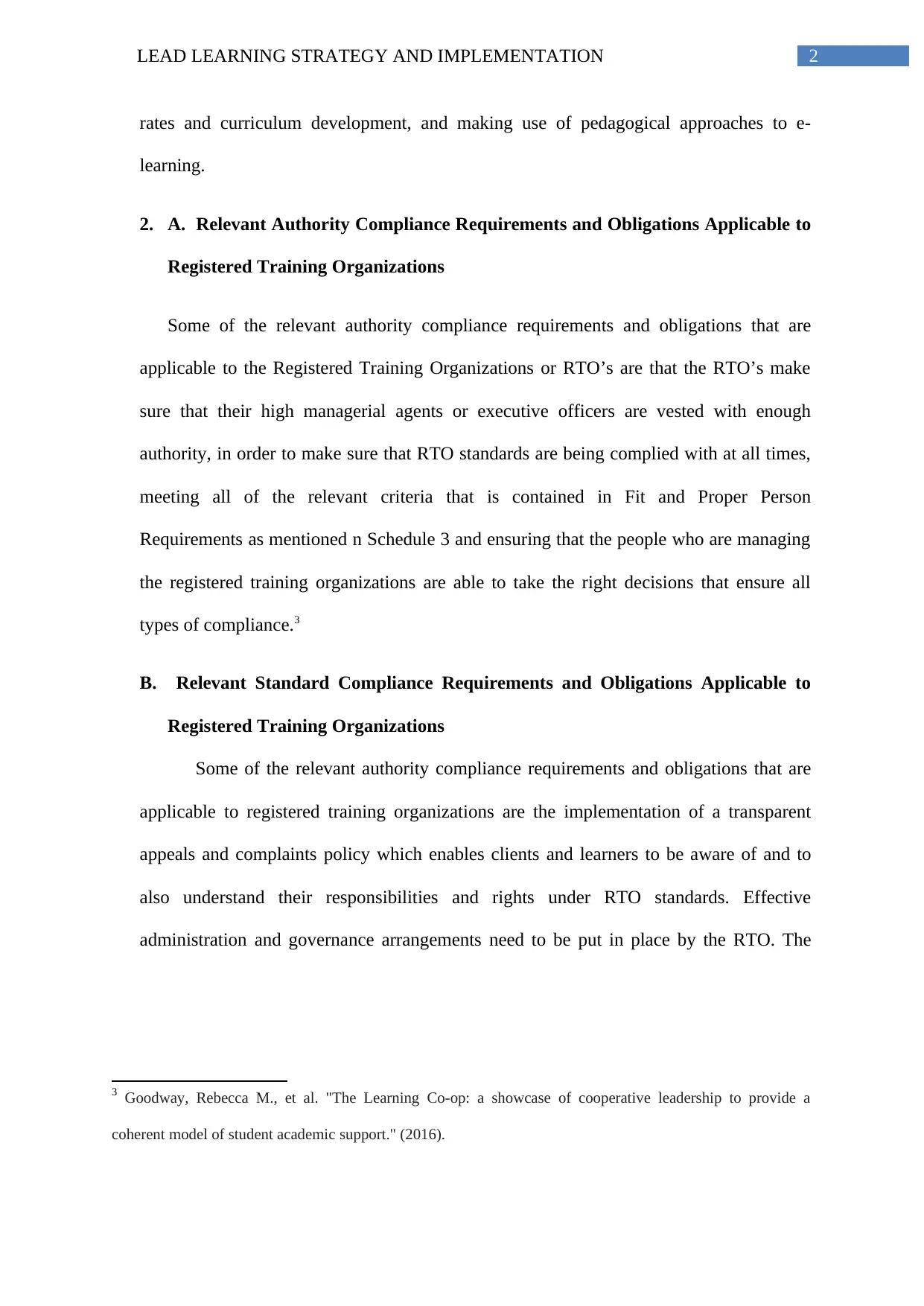
2LEAD LEARNING STRATEGY AND IMPLEMENTATION
rates and curriculum development, and making use of pedagogical approaches to e-
learning.
2. A. Relevant Authority Compliance Requirements and Obligations Applicable to
Registered Training Organizations
Some of the relevant authority compliance requirements and obligations that are
applicable to the Registered Training Organizations or RTO’s are that the RTO’s make
sure that their high managerial agents or executive officers are vested with enough
authority, in order to make sure that RTO standards are being complied with at all times,
meeting all of the relevant criteria that is contained in Fit and Proper Person
Requirements as mentioned n Schedule 3 and ensuring that the people who are managing
the registered training organizations are able to take the right decisions that ensure all
types of compliance.3
B. Relevant Standard Compliance Requirements and Obligations Applicable to
Registered Training Organizations
Some of the relevant authority compliance requirements and obligations that are
applicable to registered training organizations are the implementation of a transparent
appeals and complaints policy which enables clients and learners to be aware of and to
also understand their responsibilities and rights under RTO standards. Effective
administration and governance arrangements need to be put in place by the RTO. The
3 Goodway, Rebecca M., et al. "The Learning Co-op: a showcase of cooperative leadership to provide a
coherent model of student academic support." (2016).
rates and curriculum development, and making use of pedagogical approaches to e-
learning.
2. A. Relevant Authority Compliance Requirements and Obligations Applicable to
Registered Training Organizations
Some of the relevant authority compliance requirements and obligations that are
applicable to the Registered Training Organizations or RTO’s are that the RTO’s make
sure that their high managerial agents or executive officers are vested with enough
authority, in order to make sure that RTO standards are being complied with at all times,
meeting all of the relevant criteria that is contained in Fit and Proper Person
Requirements as mentioned n Schedule 3 and ensuring that the people who are managing
the registered training organizations are able to take the right decisions that ensure all
types of compliance.3
B. Relevant Standard Compliance Requirements and Obligations Applicable to
Registered Training Organizations
Some of the relevant authority compliance requirements and obligations that are
applicable to registered training organizations are the implementation of a transparent
appeals and complaints policy which enables clients and learners to be aware of and to
also understand their responsibilities and rights under RTO standards. Effective
administration and governance arrangements need to be put in place by the RTO. The
3 Goodway, Rebecca M., et al. "The Learning Co-op: a showcase of cooperative leadership to provide a
coherent model of student academic support." (2016).
⊘ This is a preview!⊘
Do you want full access?
Subscribe today to unlock all pages.

Trusted by 1+ million students worldwide
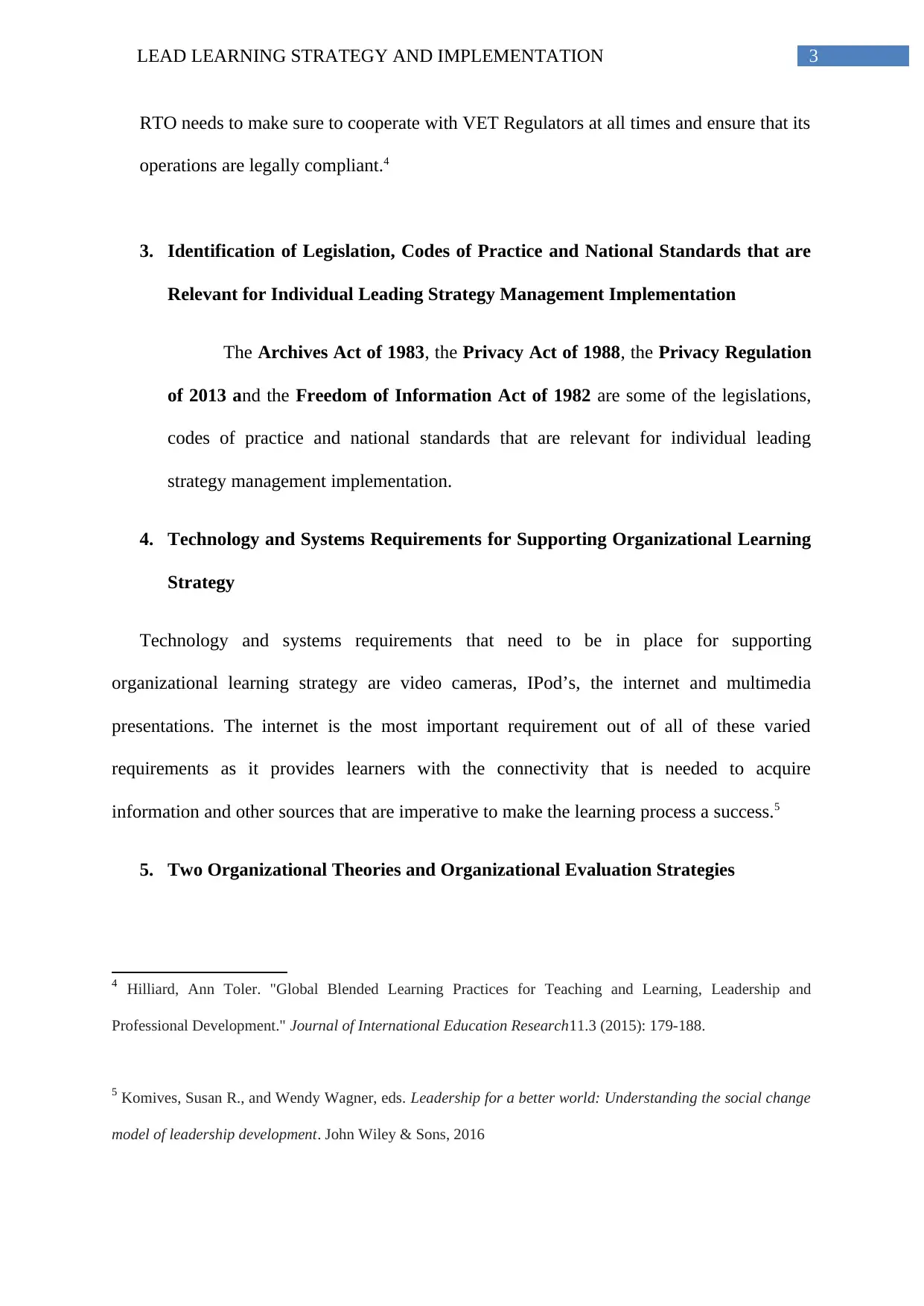
3LEAD LEARNING STRATEGY AND IMPLEMENTATION
RTO needs to make sure to cooperate with VET Regulators at all times and ensure that its
operations are legally compliant.4
3. Identification of Legislation, Codes of Practice and National Standards that are
Relevant for Individual Leading Strategy Management Implementation
The Archives Act of 1983, the Privacy Act of 1988, the Privacy Regulation
of 2013 and the Freedom of Information Act of 1982 are some of the legislations,
codes of practice and national standards that are relevant for individual leading
strategy management implementation.
4. Technology and Systems Requirements for Supporting Organizational Learning
Strategy
Technology and systems requirements that need to be in place for supporting
organizational learning strategy are video cameras, IPod’s, the internet and multimedia
presentations. The internet is the most important requirement out of all of these varied
requirements as it provides learners with the connectivity that is needed to acquire
information and other sources that are imperative to make the learning process a success.5
5. Two Organizational Theories and Organizational Evaluation Strategies
4 Hilliard, Ann Toler. "Global Blended Learning Practices for Teaching and Learning, Leadership and
Professional Development." Journal of International Education Research11.3 (2015): 179-188.
5 Komives, Susan R., and Wendy Wagner, eds. Leadership for a better world: Understanding the social change
model of leadership development. John Wiley & Sons, 2016
RTO needs to make sure to cooperate with VET Regulators at all times and ensure that its
operations are legally compliant.4
3. Identification of Legislation, Codes of Practice and National Standards that are
Relevant for Individual Leading Strategy Management Implementation
The Archives Act of 1983, the Privacy Act of 1988, the Privacy Regulation
of 2013 and the Freedom of Information Act of 1982 are some of the legislations,
codes of practice and national standards that are relevant for individual leading
strategy management implementation.
4. Technology and Systems Requirements for Supporting Organizational Learning
Strategy
Technology and systems requirements that need to be in place for supporting
organizational learning strategy are video cameras, IPod’s, the internet and multimedia
presentations. The internet is the most important requirement out of all of these varied
requirements as it provides learners with the connectivity that is needed to acquire
information and other sources that are imperative to make the learning process a success.5
5. Two Organizational Theories and Organizational Evaluation Strategies
4 Hilliard, Ann Toler. "Global Blended Learning Practices for Teaching and Learning, Leadership and
Professional Development." Journal of International Education Research11.3 (2015): 179-188.
5 Komives, Susan R., and Wendy Wagner, eds. Leadership for a better world: Understanding the social change
model of leadership development. John Wiley & Sons, 2016
Paraphrase This Document
Need a fresh take? Get an instant paraphrase of this document with our AI Paraphraser
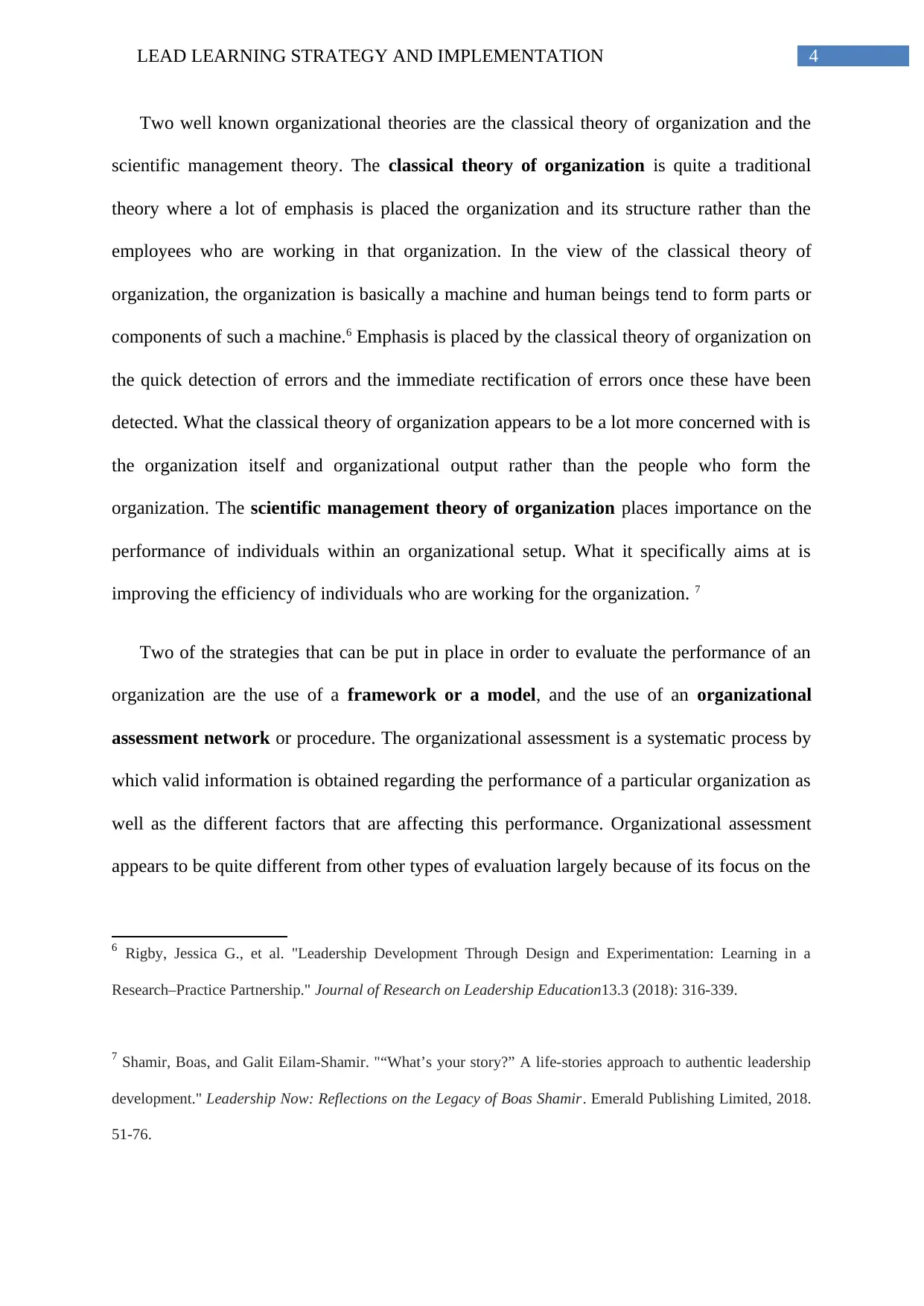
4LEAD LEARNING STRATEGY AND IMPLEMENTATION
Two well known organizational theories are the classical theory of organization and the
scientific management theory. The classical theory of organization is quite a traditional
theory where a lot of emphasis is placed the organization and its structure rather than the
employees who are working in that organization. In the view of the classical theory of
organization, the organization is basically a machine and human beings tend to form parts or
components of such a machine.6 Emphasis is placed by the classical theory of organization on
the quick detection of errors and the immediate rectification of errors once these have been
detected. What the classical theory of organization appears to be a lot more concerned with is
the organization itself and organizational output rather than the people who form the
organization. The scientific management theory of organization places importance on the
performance of individuals within an organizational setup. What it specifically aims at is
improving the efficiency of individuals who are working for the organization. 7
Two of the strategies that can be put in place in order to evaluate the performance of an
organization are the use of a framework or a model, and the use of an organizational
assessment network or procedure. The organizational assessment is a systematic process by
which valid information is obtained regarding the performance of a particular organization as
well as the different factors that are affecting this performance. Organizational assessment
appears to be quite different from other types of evaluation largely because of its focus on the
6 Rigby, Jessica G., et al. "Leadership Development Through Design and Experimentation: Learning in a
Research–Practice Partnership." Journal of Research on Leadership Education13.3 (2018): 316-339.
7 Shamir, Boas, and Galit Eilam-Shamir. "“What’s your story?” A life-stories approach to authentic leadership
development." Leadership Now: Reflections on the Legacy of Boas Shamir. Emerald Publishing Limited, 2018.
51-76.
Two well known organizational theories are the classical theory of organization and the
scientific management theory. The classical theory of organization is quite a traditional
theory where a lot of emphasis is placed the organization and its structure rather than the
employees who are working in that organization. In the view of the classical theory of
organization, the organization is basically a machine and human beings tend to form parts or
components of such a machine.6 Emphasis is placed by the classical theory of organization on
the quick detection of errors and the immediate rectification of errors once these have been
detected. What the classical theory of organization appears to be a lot more concerned with is
the organization itself and organizational output rather than the people who form the
organization. The scientific management theory of organization places importance on the
performance of individuals within an organizational setup. What it specifically aims at is
improving the efficiency of individuals who are working for the organization. 7
Two of the strategies that can be put in place in order to evaluate the performance of an
organization are the use of a framework or a model, and the use of an organizational
assessment network or procedure. The organizational assessment is a systematic process by
which valid information is obtained regarding the performance of a particular organization as
well as the different factors that are affecting this performance. Organizational assessment
appears to be quite different from other types of evaluation largely because of its focus on the
6 Rigby, Jessica G., et al. "Leadership Development Through Design and Experimentation: Learning in a
Research–Practice Partnership." Journal of Research on Leadership Education13.3 (2018): 316-339.
7 Shamir, Boas, and Galit Eilam-Shamir. "“What’s your story?” A life-stories approach to authentic leadership
development." Leadership Now: Reflections on the Legacy of Boas Shamir. Emerald Publishing Limited, 2018.
51-76.
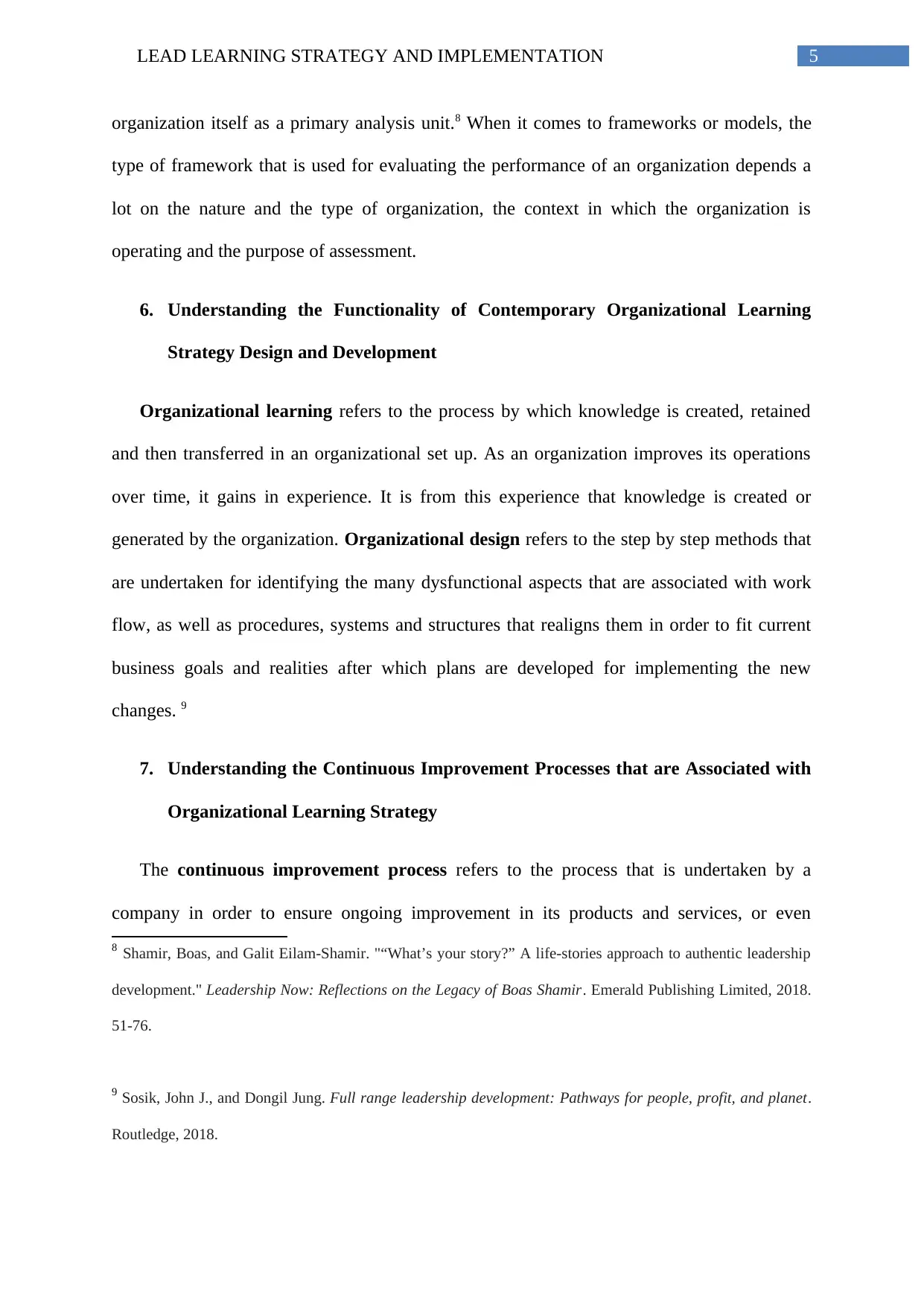
5LEAD LEARNING STRATEGY AND IMPLEMENTATION
organization itself as a primary analysis unit.8 When it comes to frameworks or models, the
type of framework that is used for evaluating the performance of an organization depends a
lot on the nature and the type of organization, the context in which the organization is
operating and the purpose of assessment.
6. Understanding the Functionality of Contemporary Organizational Learning
Strategy Design and Development
Organizational learning refers to the process by which knowledge is created, retained
and then transferred in an organizational set up. As an organization improves its operations
over time, it gains in experience. It is from this experience that knowledge is created or
generated by the organization. Organizational design refers to the step by step methods that
are undertaken for identifying the many dysfunctional aspects that are associated with work
flow, as well as procedures, systems and structures that realigns them in order to fit current
business goals and realities after which plans are developed for implementing the new
changes. 9
7. Understanding the Continuous Improvement Processes that are Associated with
Organizational Learning Strategy
The continuous improvement process refers to the process that is undertaken by a
company in order to ensure ongoing improvement in its products and services, or even
8 Shamir, Boas, and Galit Eilam-Shamir. "“What’s your story?” A life-stories approach to authentic leadership
development." Leadership Now: Reflections on the Legacy of Boas Shamir. Emerald Publishing Limited, 2018.
51-76.
9 Sosik, John J., and Dongil Jung. Full range leadership development: Pathways for people, profit, and planet.
Routledge, 2018.
organization itself as a primary analysis unit.8 When it comes to frameworks or models, the
type of framework that is used for evaluating the performance of an organization depends a
lot on the nature and the type of organization, the context in which the organization is
operating and the purpose of assessment.
6. Understanding the Functionality of Contemporary Organizational Learning
Strategy Design and Development
Organizational learning refers to the process by which knowledge is created, retained
and then transferred in an organizational set up. As an organization improves its operations
over time, it gains in experience. It is from this experience that knowledge is created or
generated by the organization. Organizational design refers to the step by step methods that
are undertaken for identifying the many dysfunctional aspects that are associated with work
flow, as well as procedures, systems and structures that realigns them in order to fit current
business goals and realities after which plans are developed for implementing the new
changes. 9
7. Understanding the Continuous Improvement Processes that are Associated with
Organizational Learning Strategy
The continuous improvement process refers to the process that is undertaken by a
company in order to ensure ongoing improvement in its products and services, or even
8 Shamir, Boas, and Galit Eilam-Shamir. "“What’s your story?” A life-stories approach to authentic leadership
development." Leadership Now: Reflections on the Legacy of Boas Shamir. Emerald Publishing Limited, 2018.
51-76.
9 Sosik, John J., and Dongil Jung. Full range leadership development: Pathways for people, profit, and planet.
Routledge, 2018.
⊘ This is a preview!⊘
Do you want full access?
Subscribe today to unlock all pages.

Trusted by 1+ million students worldwide
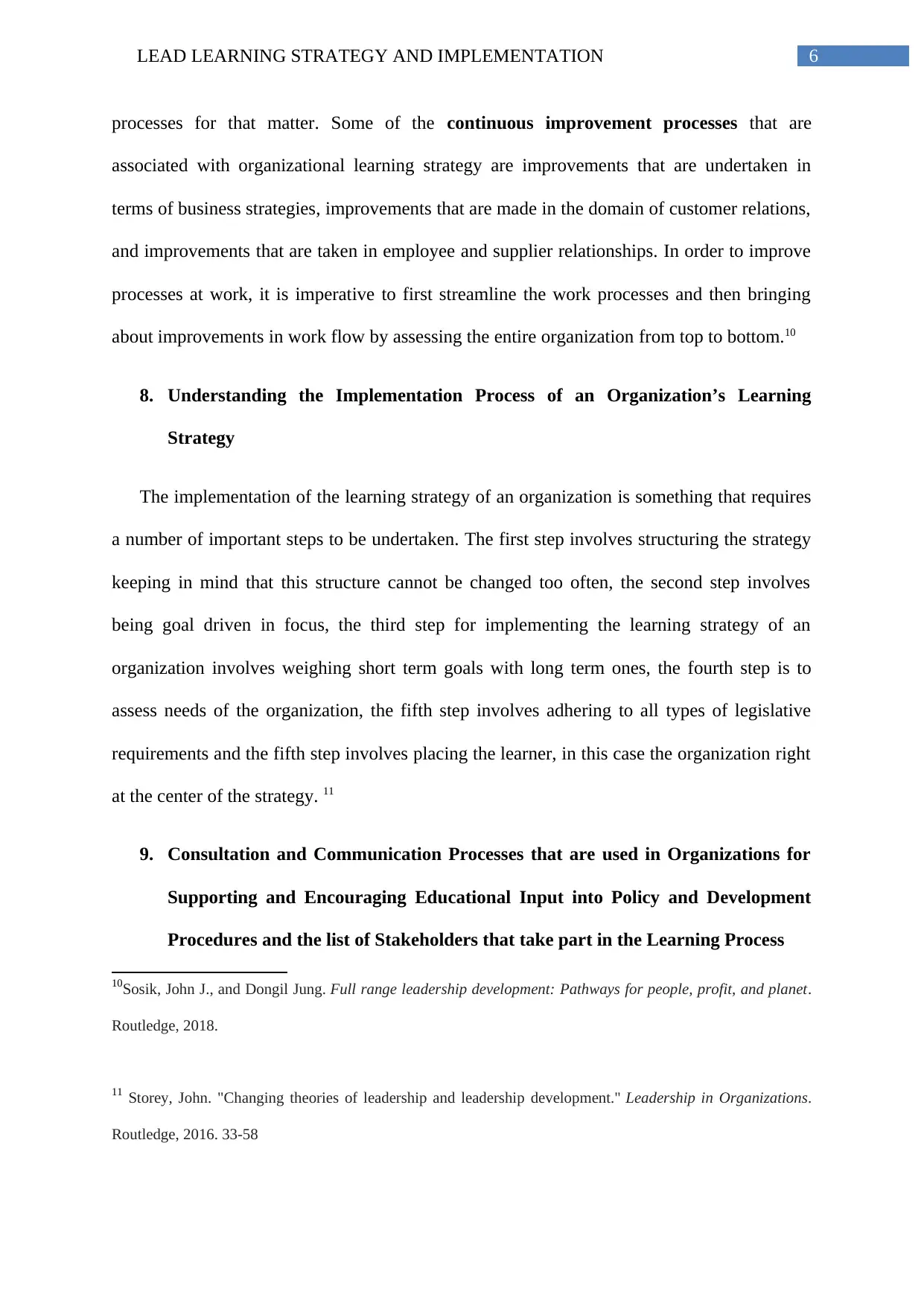
6LEAD LEARNING STRATEGY AND IMPLEMENTATION
processes for that matter. Some of the continuous improvement processes that are
associated with organizational learning strategy are improvements that are undertaken in
terms of business strategies, improvements that are made in the domain of customer relations,
and improvements that are taken in employee and supplier relationships. In order to improve
processes at work, it is imperative to first streamline the work processes and then bringing
about improvements in work flow by assessing the entire organization from top to bottom.10
8. Understanding the Implementation Process of an Organization’s Learning
Strategy
The implementation of the learning strategy of an organization is something that requires
a number of important steps to be undertaken. The first step involves structuring the strategy
keeping in mind that this structure cannot be changed too often, the second step involves
being goal driven in focus, the third step for implementing the learning strategy of an
organization involves weighing short term goals with long term ones, the fourth step is to
assess needs of the organization, the fifth step involves adhering to all types of legislative
requirements and the fifth step involves placing the learner, in this case the organization right
at the center of the strategy. 11
9. Consultation and Communication Processes that are used in Organizations for
Supporting and Encouraging Educational Input into Policy and Development
Procedures and the list of Stakeholders that take part in the Learning Process
10Sosik, John J., and Dongil Jung. Full range leadership development: Pathways for people, profit, and planet.
Routledge, 2018.
11 Storey, John. "Changing theories of leadership and leadership development." Leadership in Organizations.
Routledge, 2016. 33-58
processes for that matter. Some of the continuous improvement processes that are
associated with organizational learning strategy are improvements that are undertaken in
terms of business strategies, improvements that are made in the domain of customer relations,
and improvements that are taken in employee and supplier relationships. In order to improve
processes at work, it is imperative to first streamline the work processes and then bringing
about improvements in work flow by assessing the entire organization from top to bottom.10
8. Understanding the Implementation Process of an Organization’s Learning
Strategy
The implementation of the learning strategy of an organization is something that requires
a number of important steps to be undertaken. The first step involves structuring the strategy
keeping in mind that this structure cannot be changed too often, the second step involves
being goal driven in focus, the third step for implementing the learning strategy of an
organization involves weighing short term goals with long term ones, the fourth step is to
assess needs of the organization, the fifth step involves adhering to all types of legislative
requirements and the fifth step involves placing the learner, in this case the organization right
at the center of the strategy. 11
9. Consultation and Communication Processes that are used in Organizations for
Supporting and Encouraging Educational Input into Policy and Development
Procedures and the list of Stakeholders that take part in the Learning Process
10Sosik, John J., and Dongil Jung. Full range leadership development: Pathways for people, profit, and planet.
Routledge, 2018.
11 Storey, John. "Changing theories of leadership and leadership development." Leadership in Organizations.
Routledge, 2016. 33-58
Paraphrase This Document
Need a fresh take? Get an instant paraphrase of this document with our AI Paraphraser
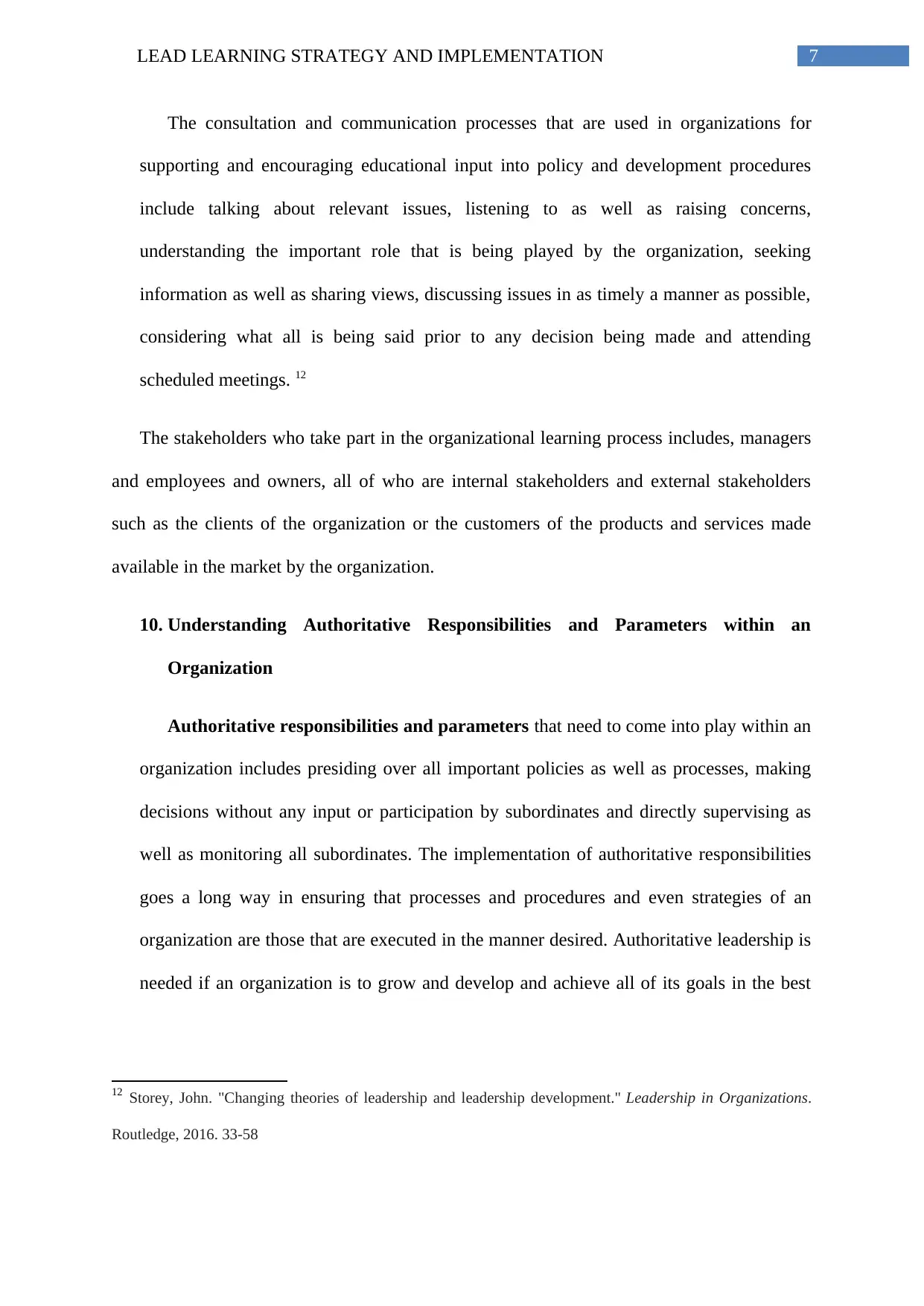
7LEAD LEARNING STRATEGY AND IMPLEMENTATION
The consultation and communication processes that are used in organizations for
supporting and encouraging educational input into policy and development procedures
include talking about relevant issues, listening to as well as raising concerns,
understanding the important role that is being played by the organization, seeking
information as well as sharing views, discussing issues in as timely a manner as possible,
considering what all is being said prior to any decision being made and attending
scheduled meetings. 12
The stakeholders who take part in the organizational learning process includes, managers
and employees and owners, all of who are internal stakeholders and external stakeholders
such as the clients of the organization or the customers of the products and services made
available in the market by the organization.
10. Understanding Authoritative Responsibilities and Parameters within an
Organization
Authoritative responsibilities and parameters that need to come into play within an
organization includes presiding over all important policies as well as processes, making
decisions without any input or participation by subordinates and directly supervising as
well as monitoring all subordinates. The implementation of authoritative responsibilities
goes a long way in ensuring that processes and procedures and even strategies of an
organization are those that are executed in the manner desired. Authoritative leadership is
needed if an organization is to grow and develop and achieve all of its goals in the best
12 Storey, John. "Changing theories of leadership and leadership development." Leadership in Organizations.
Routledge, 2016. 33-58
The consultation and communication processes that are used in organizations for
supporting and encouraging educational input into policy and development procedures
include talking about relevant issues, listening to as well as raising concerns,
understanding the important role that is being played by the organization, seeking
information as well as sharing views, discussing issues in as timely a manner as possible,
considering what all is being said prior to any decision being made and attending
scheduled meetings. 12
The stakeholders who take part in the organizational learning process includes, managers
and employees and owners, all of who are internal stakeholders and external stakeholders
such as the clients of the organization or the customers of the products and services made
available in the market by the organization.
10. Understanding Authoritative Responsibilities and Parameters within an
Organization
Authoritative responsibilities and parameters that need to come into play within an
organization includes presiding over all important policies as well as processes, making
decisions without any input or participation by subordinates and directly supervising as
well as monitoring all subordinates. The implementation of authoritative responsibilities
goes a long way in ensuring that processes and procedures and even strategies of an
organization are those that are executed in the manner desired. Authoritative leadership is
needed if an organization is to grow and develop and achieve all of its goals in the best
12 Storey, John. "Changing theories of leadership and leadership development." Leadership in Organizations.
Routledge, 2016. 33-58
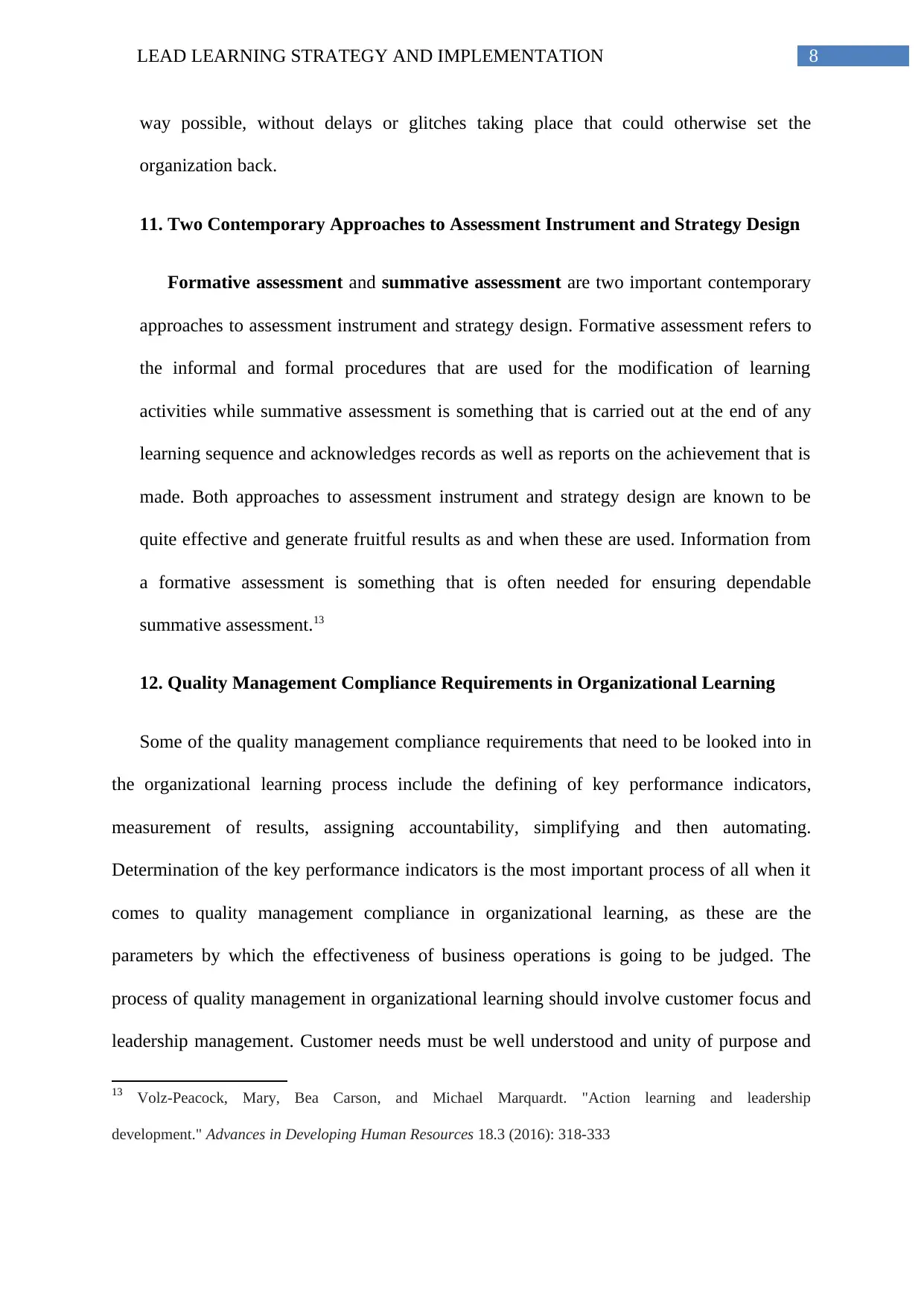
8LEAD LEARNING STRATEGY AND IMPLEMENTATION
way possible, without delays or glitches taking place that could otherwise set the
organization back.
11. Two Contemporary Approaches to Assessment Instrument and Strategy Design
Formative assessment and summative assessment are two important contemporary
approaches to assessment instrument and strategy design. Formative assessment refers to
the informal and formal procedures that are used for the modification of learning
activities while summative assessment is something that is carried out at the end of any
learning sequence and acknowledges records as well as reports on the achievement that is
made. Both approaches to assessment instrument and strategy design are known to be
quite effective and generate fruitful results as and when these are used. Information from
a formative assessment is something that is often needed for ensuring dependable
summative assessment.13
12. Quality Management Compliance Requirements in Organizational Learning
Some of the quality management compliance requirements that need to be looked into in
the organizational learning process include the defining of key performance indicators,
measurement of results, assigning accountability, simplifying and then automating.
Determination of the key performance indicators is the most important process of all when it
comes to quality management compliance in organizational learning, as these are the
parameters by which the effectiveness of business operations is going to be judged. The
process of quality management in organizational learning should involve customer focus and
leadership management. Customer needs must be well understood and unity of purpose and
13 Volz-Peacock, Mary, Bea Carson, and Michael Marquardt. "Action learning and leadership
development." Advances in Developing Human Resources 18.3 (2016): 318-333
way possible, without delays or glitches taking place that could otherwise set the
organization back.
11. Two Contemporary Approaches to Assessment Instrument and Strategy Design
Formative assessment and summative assessment are two important contemporary
approaches to assessment instrument and strategy design. Formative assessment refers to
the informal and formal procedures that are used for the modification of learning
activities while summative assessment is something that is carried out at the end of any
learning sequence and acknowledges records as well as reports on the achievement that is
made. Both approaches to assessment instrument and strategy design are known to be
quite effective and generate fruitful results as and when these are used. Information from
a formative assessment is something that is often needed for ensuring dependable
summative assessment.13
12. Quality Management Compliance Requirements in Organizational Learning
Some of the quality management compliance requirements that need to be looked into in
the organizational learning process include the defining of key performance indicators,
measurement of results, assigning accountability, simplifying and then automating.
Determination of the key performance indicators is the most important process of all when it
comes to quality management compliance in organizational learning, as these are the
parameters by which the effectiveness of business operations is going to be judged. The
process of quality management in organizational learning should involve customer focus and
leadership management. Customer needs must be well understood and unity of purpose and
13 Volz-Peacock, Mary, Bea Carson, and Michael Marquardt. "Action learning and leadership
development." Advances in Developing Human Resources 18.3 (2016): 318-333
⊘ This is a preview!⊘
Do you want full access?
Subscribe today to unlock all pages.

Trusted by 1+ million students worldwide
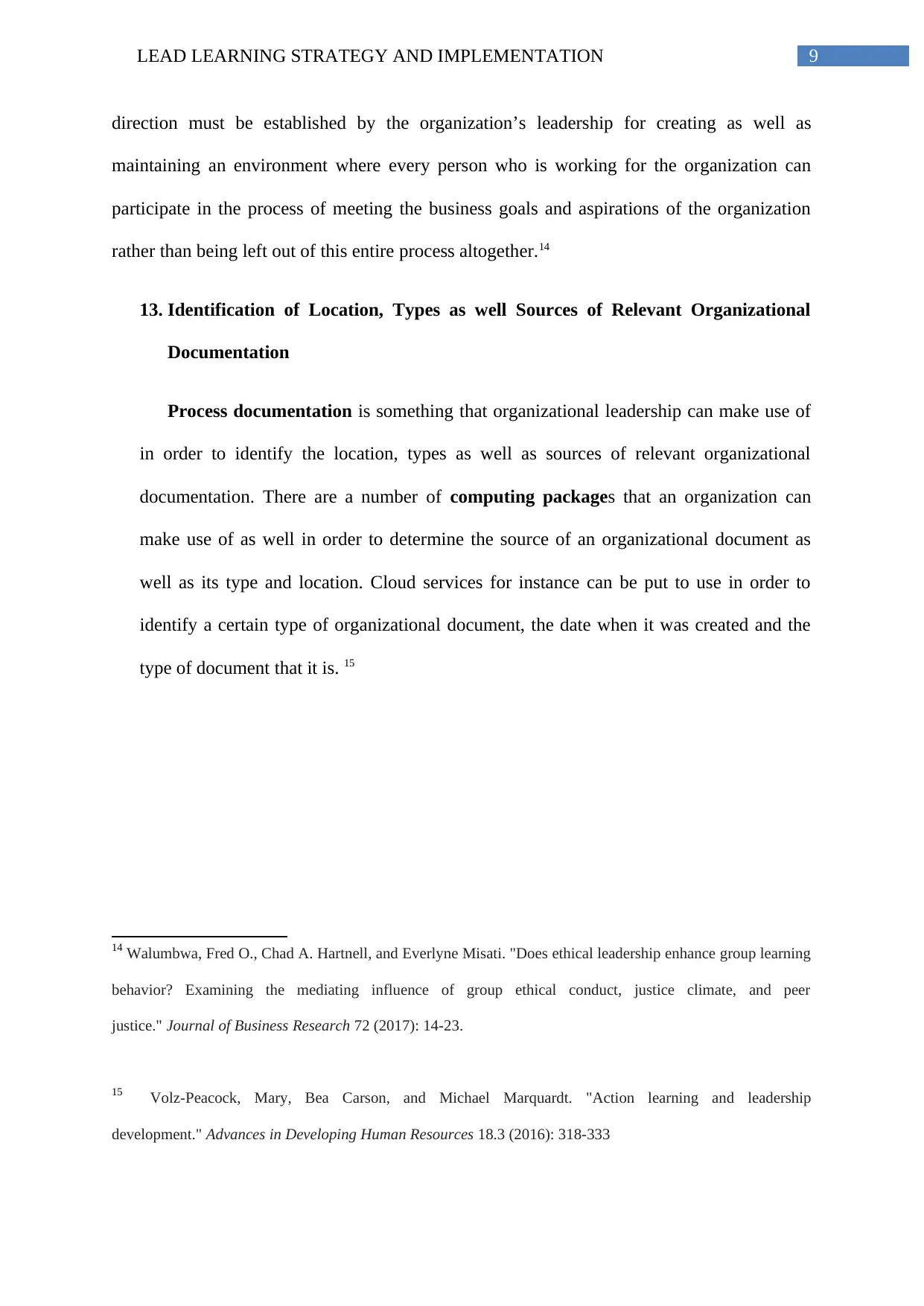
9LEAD LEARNING STRATEGY AND IMPLEMENTATION
direction must be established by the organization’s leadership for creating as well as
maintaining an environment where every person who is working for the organization can
participate in the process of meeting the business goals and aspirations of the organization
rather than being left out of this entire process altogether.14
13. Identification of Location, Types as well Sources of Relevant Organizational
Documentation
Process documentation is something that organizational leadership can make use of
in order to identify the location, types as well as sources of relevant organizational
documentation. There are a number of computing packages that an organization can
make use of as well in order to determine the source of an organizational document as
well as its type and location. Cloud services for instance can be put to use in order to
identify a certain type of organizational document, the date when it was created and the
type of document that it is. 15
14 Walumbwa, Fred O., Chad A. Hartnell, and Everlyne Misati. "Does ethical leadership enhance group learning
behavior? Examining the mediating influence of group ethical conduct, justice climate, and peer
justice." Journal of Business Research 72 (2017): 14-23.
15 Volz-Peacock, Mary, Bea Carson, and Michael Marquardt. "Action learning and leadership
development." Advances in Developing Human Resources 18.3 (2016): 318-333
direction must be established by the organization’s leadership for creating as well as
maintaining an environment where every person who is working for the organization can
participate in the process of meeting the business goals and aspirations of the organization
rather than being left out of this entire process altogether.14
13. Identification of Location, Types as well Sources of Relevant Organizational
Documentation
Process documentation is something that organizational leadership can make use of
in order to identify the location, types as well as sources of relevant organizational
documentation. There are a number of computing packages that an organization can
make use of as well in order to determine the source of an organizational document as
well as its type and location. Cloud services for instance can be put to use in order to
identify a certain type of organizational document, the date when it was created and the
type of document that it is. 15
14 Walumbwa, Fred O., Chad A. Hartnell, and Everlyne Misati. "Does ethical leadership enhance group learning
behavior? Examining the mediating influence of group ethical conduct, justice climate, and peer
justice." Journal of Business Research 72 (2017): 14-23.
15 Volz-Peacock, Mary, Bea Carson, and Michael Marquardt. "Action learning and leadership
development." Advances in Developing Human Resources 18.3 (2016): 318-333
Paraphrase This Document
Need a fresh take? Get an instant paraphrase of this document with our AI Paraphraser
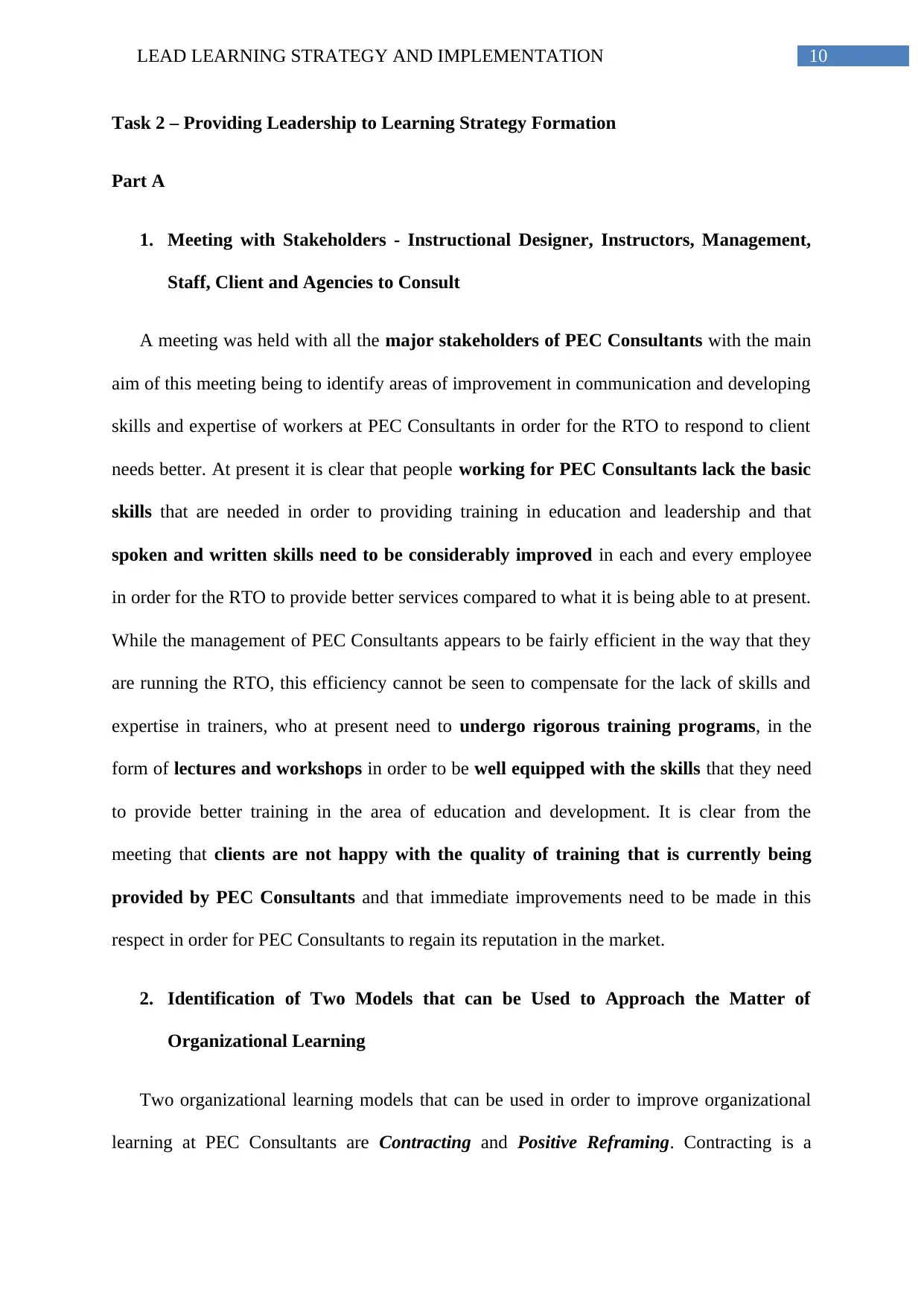
10LEAD LEARNING STRATEGY AND IMPLEMENTATION
Task 2 – Providing Leadership to Learning Strategy Formation
Part A
1. Meeting with Stakeholders - Instructional Designer, Instructors, Management,
Staff, Client and Agencies to Consult
A meeting was held with all the major stakeholders of PEC Consultants with the main
aim of this meeting being to identify areas of improvement in communication and developing
skills and expertise of workers at PEC Consultants in order for the RTO to respond to client
needs better. At present it is clear that people working for PEC Consultants lack the basic
skills that are needed in order to providing training in education and leadership and that
spoken and written skills need to be considerably improved in each and every employee
in order for the RTO to provide better services compared to what it is being able to at present.
While the management of PEC Consultants appears to be fairly efficient in the way that they
are running the RTO, this efficiency cannot be seen to compensate for the lack of skills and
expertise in trainers, who at present need to undergo rigorous training programs, in the
form of lectures and workshops in order to be well equipped with the skills that they need
to provide better training in the area of education and development. It is clear from the
meeting that clients are not happy with the quality of training that is currently being
provided by PEC Consultants and that immediate improvements need to be made in this
respect in order for PEC Consultants to regain its reputation in the market.
2. Identification of Two Models that can be Used to Approach the Matter of
Organizational Learning
Two organizational learning models that can be used in order to improve organizational
learning at PEC Consultants are Contracting and Positive Reframing. Contracting is a
Task 2 – Providing Leadership to Learning Strategy Formation
Part A
1. Meeting with Stakeholders - Instructional Designer, Instructors, Management,
Staff, Client and Agencies to Consult
A meeting was held with all the major stakeholders of PEC Consultants with the main
aim of this meeting being to identify areas of improvement in communication and developing
skills and expertise of workers at PEC Consultants in order for the RTO to respond to client
needs better. At present it is clear that people working for PEC Consultants lack the basic
skills that are needed in order to providing training in education and leadership and that
spoken and written skills need to be considerably improved in each and every employee
in order for the RTO to provide better services compared to what it is being able to at present.
While the management of PEC Consultants appears to be fairly efficient in the way that they
are running the RTO, this efficiency cannot be seen to compensate for the lack of skills and
expertise in trainers, who at present need to undergo rigorous training programs, in the
form of lectures and workshops in order to be well equipped with the skills that they need
to provide better training in the area of education and development. It is clear from the
meeting that clients are not happy with the quality of training that is currently being
provided by PEC Consultants and that immediate improvements need to be made in this
respect in order for PEC Consultants to regain its reputation in the market.
2. Identification of Two Models that can be Used to Approach the Matter of
Organizational Learning
Two organizational learning models that can be used in order to improve organizational
learning at PEC Consultants are Contracting and Positive Reframing. Contracting is a
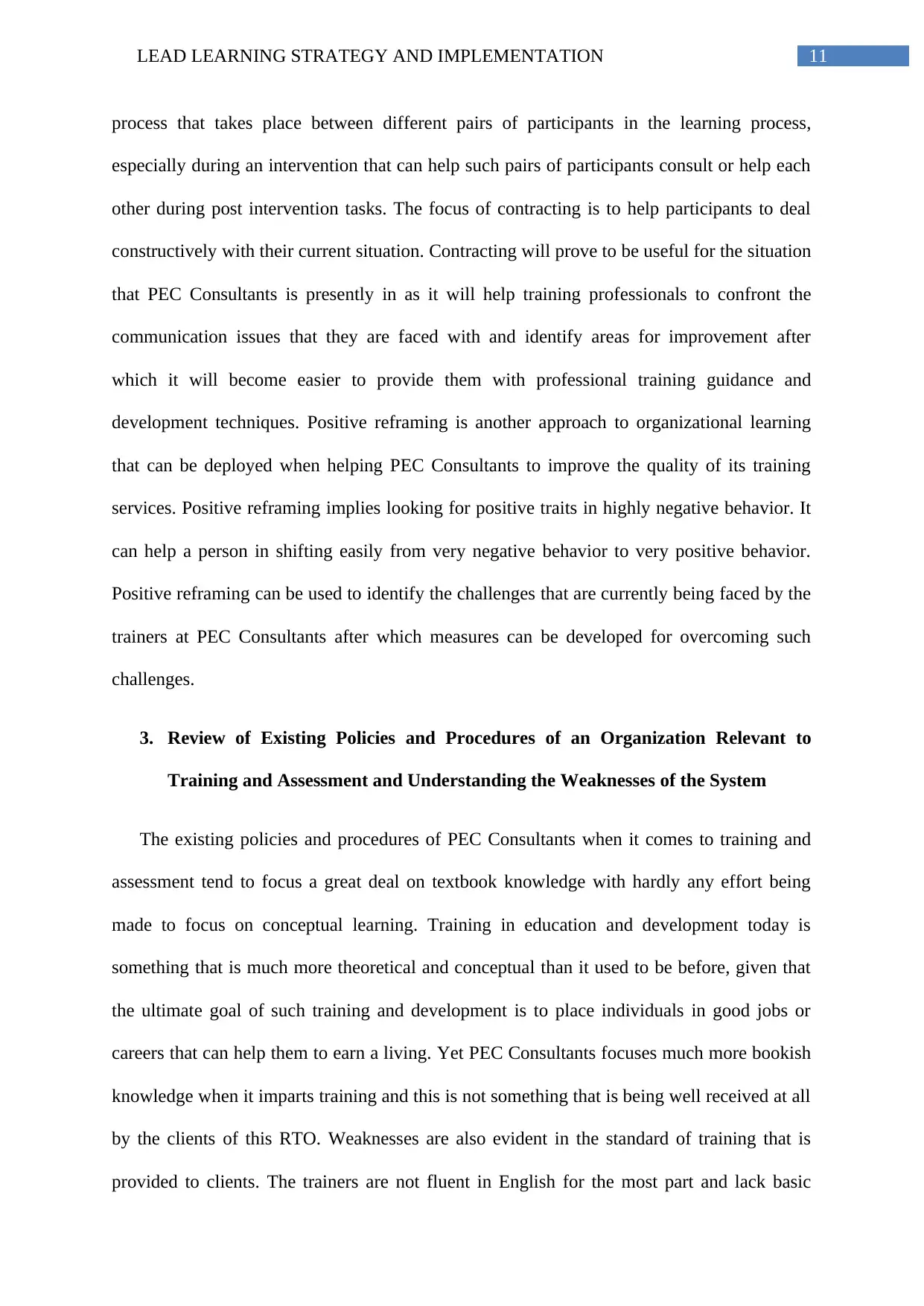
11LEAD LEARNING STRATEGY AND IMPLEMENTATION
process that takes place between different pairs of participants in the learning process,
especially during an intervention that can help such pairs of participants consult or help each
other during post intervention tasks. The focus of contracting is to help participants to deal
constructively with their current situation. Contracting will prove to be useful for the situation
that PEC Consultants is presently in as it will help training professionals to confront the
communication issues that they are faced with and identify areas for improvement after
which it will become easier to provide them with professional training guidance and
development techniques. Positive reframing is another approach to organizational learning
that can be deployed when helping PEC Consultants to improve the quality of its training
services. Positive reframing implies looking for positive traits in highly negative behavior. It
can help a person in shifting easily from very negative behavior to very positive behavior.
Positive reframing can be used to identify the challenges that are currently being faced by the
trainers at PEC Consultants after which measures can be developed for overcoming such
challenges.
3. Review of Existing Policies and Procedures of an Organization Relevant to
Training and Assessment and Understanding the Weaknesses of the System
The existing policies and procedures of PEC Consultants when it comes to training and
assessment tend to focus a great deal on textbook knowledge with hardly any effort being
made to focus on conceptual learning. Training in education and development today is
something that is much more theoretical and conceptual than it used to be before, given that
the ultimate goal of such training and development is to place individuals in good jobs or
careers that can help them to earn a living. Yet PEC Consultants focuses much more bookish
knowledge when it imparts training and this is not something that is being well received at all
by the clients of this RTO. Weaknesses are also evident in the standard of training that is
provided to clients. The trainers are not fluent in English for the most part and lack basic
process that takes place between different pairs of participants in the learning process,
especially during an intervention that can help such pairs of participants consult or help each
other during post intervention tasks. The focus of contracting is to help participants to deal
constructively with their current situation. Contracting will prove to be useful for the situation
that PEC Consultants is presently in as it will help training professionals to confront the
communication issues that they are faced with and identify areas for improvement after
which it will become easier to provide them with professional training guidance and
development techniques. Positive reframing is another approach to organizational learning
that can be deployed when helping PEC Consultants to improve the quality of its training
services. Positive reframing implies looking for positive traits in highly negative behavior. It
can help a person in shifting easily from very negative behavior to very positive behavior.
Positive reframing can be used to identify the challenges that are currently being faced by the
trainers at PEC Consultants after which measures can be developed for overcoming such
challenges.
3. Review of Existing Policies and Procedures of an Organization Relevant to
Training and Assessment and Understanding the Weaknesses of the System
The existing policies and procedures of PEC Consultants when it comes to training and
assessment tend to focus a great deal on textbook knowledge with hardly any effort being
made to focus on conceptual learning. Training in education and development today is
something that is much more theoretical and conceptual than it used to be before, given that
the ultimate goal of such training and development is to place individuals in good jobs or
careers that can help them to earn a living. Yet PEC Consultants focuses much more bookish
knowledge when it imparts training and this is not something that is being well received at all
by the clients of this RTO. Weaknesses are also evident in the standard of training that is
provided to clients. The trainers are not fluent in English for the most part and lack basic
⊘ This is a preview!⊘
Do you want full access?
Subscribe today to unlock all pages.

Trusted by 1+ million students worldwide
1 out of 24
Related Documents
Your All-in-One AI-Powered Toolkit for Academic Success.
+13062052269
info@desklib.com
Available 24*7 on WhatsApp / Email
![[object Object]](/_next/static/media/star-bottom.7253800d.svg)
Unlock your academic potential
Copyright © 2020–2025 A2Z Services. All Rights Reserved. Developed and managed by ZUCOL.



